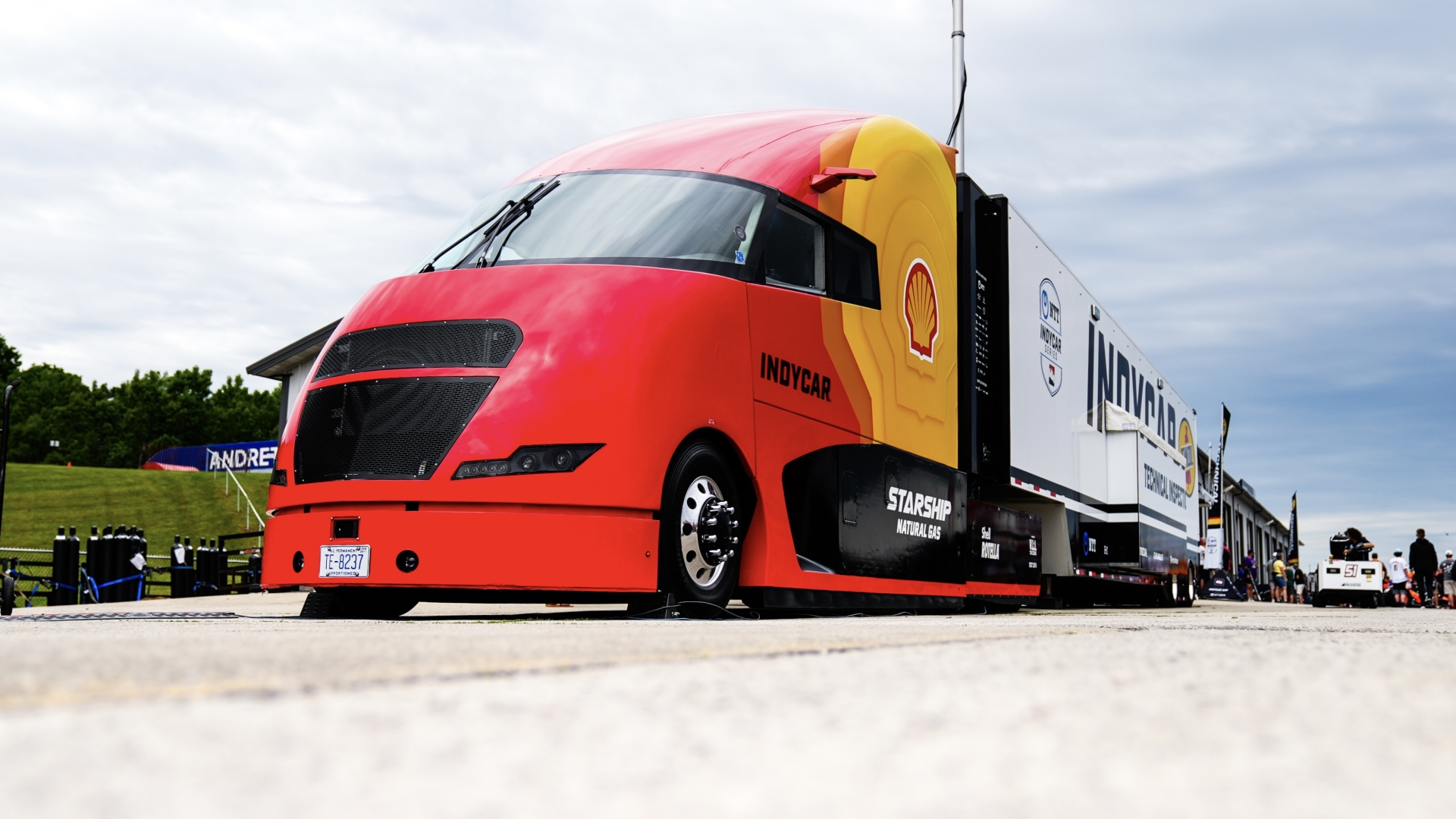Turning concept into capability: X15N and Shell Starship’s road to racing
By Tom Quimby, On-highway Journalist

Shell Starship 3.0, one of the most aerodynamic tractor-trailers on the road, has moved beyond test routes and into the high-performance world of INDYCAR. It now serves as a key member of the racing series’ transportation fleet.
Powered by the Cummins X15N™, the cleanest heavy-duty natural gas engine on the market, Starship 3.0 is demonstrating that natural gas technology is not just a reality in commercial operations, it can meet the demanding needs of a nationwide logistics schedule like INDYCAR’s.
This real-world milestone did not happen overnight.
Shell first made headlines in 2018, unveiling Starship at the Technology & Maintenance Council's (TMC) Annual Meeting & Transportation Technology meeting in Atlanta, Georgia. Five years later, Shell introduced the third generation at the Advanced Clean Transportation Expo in Anaheim, California. It became the first iteration of the concept truck to utilize an X15N.
Designed to lower emissions while increasing freight-ton efficiency, prior Starship iterations featured Cummins X15 diesel engines. Paired with the X15N, the current Starship not only dropped to near-zero emissions but also achieved a negative carbon intensity score when fueled with renewable natural gas (RNG).
During testing, Shell reported that the current Starship achieved 9 mpg while delivering power comparable to diesel-powered trucks, something previous natural gas engines have struggled to offer Class 8 fleets and owner-operators.
“The X15N with its higher power and higher torque opens lots of doors for new markets,” said David King, Cummins Engine Business Unit On-Highway Product Manager.
One of those new markets includes auto racing. Eager to cut emissions at its popular racing events by 50% by 2030, INDYCAR announced in May that Starship 3.0 would become the first natural gas-powered Class 8 truck to go to work for a national motorsports fleet in North America.
Since early June, the truck has been handling the real-world challenge of hauling the 73,000 lb. Pennzoil Tech Inspection Trailer to various racing events fueled on RNG. No stranger to lowering emissions, Shell first began supplying INDYCAR with 100% renewable racing fuel for its series events in 2023. Reducing emissions beyond the track was the next step.
“The Shell Starship 3.0 has built on that relationship by reducing emissions now for operations,” said Scott Burian, Global Integrated Communications Manager at Shell. “When fueled by renewable natural gas, there’s a carbon intensity reduction compared to standard fuel. So now we're helping them reduce emissions from track to track, whereas there are renewable racing fuels helping them do this on the track.”
Drivers trade shifts driving the 53-foot trailer which includes city and highway driving.
“The feedback we've gotten from the drivers is that it's very diesel-like in terms of power and performance,” said Ryan Manthiri, Project Leader in Shell’s Global Solutions Technology Group. “They travel an average of 65 to 75 miles per hour depending on the speed limit and there’s been no lag. In terms of what they typically haul, the performance, power and the ease of shift, the feedback we've gotten is positive so far.”
The truck is also getting more attention at INDYCAR events than it did while testing in California and elsewhere.
“Lots of people have gathered around it, asking a ton of questions,” Burian said. “We actually had to get a sign made to help answer some of these questions and get people more information about the truck.”
While the sleek aerodynamic features of Starship attract attention, it is the X15N that steals the show.
“That’s what we’ve talked to the media the most about. People are curious about the engine,” Burian said. “It’s definitely a talking point for sure, the power behind the truck. And you know, that was the big evolution from the first two Starships.”
Chad Fohne, Cummins Global Fuel Delivery System Integration Leader, noted that the additional publicity has also helped bring attention to RNG.
“It certainly opened up the opportunity to speak more about natural gas and specifically the environmental benefits from RNG,” Fohne said. “From my perspective it's amazing that people we talk to even in the industry aren't aware of the availability of RNG and the impact it can have on reducing their carbon footprint.”
Working to get it right
Shell consulted with Cummins Clean Fuel Technologies (CCFT) to simplify one debate centered on fuel system installation.
The widely adopted choice of installing a back-of-cab tank would have interfered with Starship’s aerodynamic features while proving more challenging and costly. CCFT helped determine rail-mounted tanks would be the fitting solution. Two 60 diesel gallon equivalent (DGE) tanks from CCFT provide plenty of range, according to Shell.
“We get between 600 and 800 miles on a single fill,” Manthiri said. “It just depends on how economical and how smart the drivers are being with the truck.”
Having a natural gas system in place also meant stepping up safety features and safety inspections.
“We've got (methane)detectors throughout the truck. It's another thing that we put in above and beyond what is typically done so we can pick up any kind of potential leaks,” Manthiri said. “We check and test shutoff valves. The vent systems are another important thing that you have to look at to do. In addition to this because you're dealing with gas, there's the fire safety inspections that we have to do for pressurized gas.”
Modifications were required to the back of Starship 3.0 to accommodate the front of the Pennzoil Tech Inspection trailer which is slightly larger than prior trailers Starship has hauled.
Modifications were needed to accommodate the larger Pennzoil Tech Inspection trailer, including removing the truck’s automatic gap-sealing wings and adjusting the fifth wheel placement to avoid contact with the cab, according to Manthiri.
The additional work was worth it, Manthiri pointed out as more data comes streaming in to show the efficiencies of aerodynamic design along with Cummins’ X15N paired with the Eaton Cummins Endurant HD N.
“We've had a lot of leeway in terms of how we want to modify and innovate but in a space where it's accessible, using technologies that are off the shelf,” Manthiri said. “We don't want to try and do stuff that the average fleet and owner operator can't get their hands on because then we're designing for a future scenario versus what is needed now.”
Such decisions align with Cummins’ commitment to providing products that help customers improve their bottom line by running more efficiently.
“What's really unique about the Starship is while it’s super slippery aero, it's not advanced technology,” he said. “It's a production engine, production transmission, the driveline, tires are all production type of equipment. You can buy them. Not all of them are mainstream but they're production.
“It's all stuff that's possible. Somebody can do that with their truck. And while they may not have the bullet train look on their truck to get that last part of it, they can employ these technologies today and get closer to that greater performance than where they've been before.”
Shell and its partners will analyze the data collected from Starship 3.0’s journey along the INDYCAR circuit to assess how the truck and its Cummins X15N engine performed under real-world conditions, including diverse routes, changing weather and demanding schedules. The full findings are expected to be released following a comprehensive review in the weeks after INDYCAR’s final race on August 31.
Author Profiles

Tom Quimby, On-highway Journalist
Tom Quimby, On-highway Journalist, has a broad range of experience covering various topics for local and national periodicals. His stories and photos have appeared in The Washington Times and more recently in Commercial Carrier Journal, Overdrive, Hard Working Trucks, Equipment World and Total Landscape Care. Tom has reported on Class 1 – 8 commercial vehicles since 2015. A graduate of the University of Southern California, Tom enjoyed growing up around hot rods, dirt bikes, deserts and beaches near San Diego. He now calls Northwest Florida home.
Related Topics
Related Tags